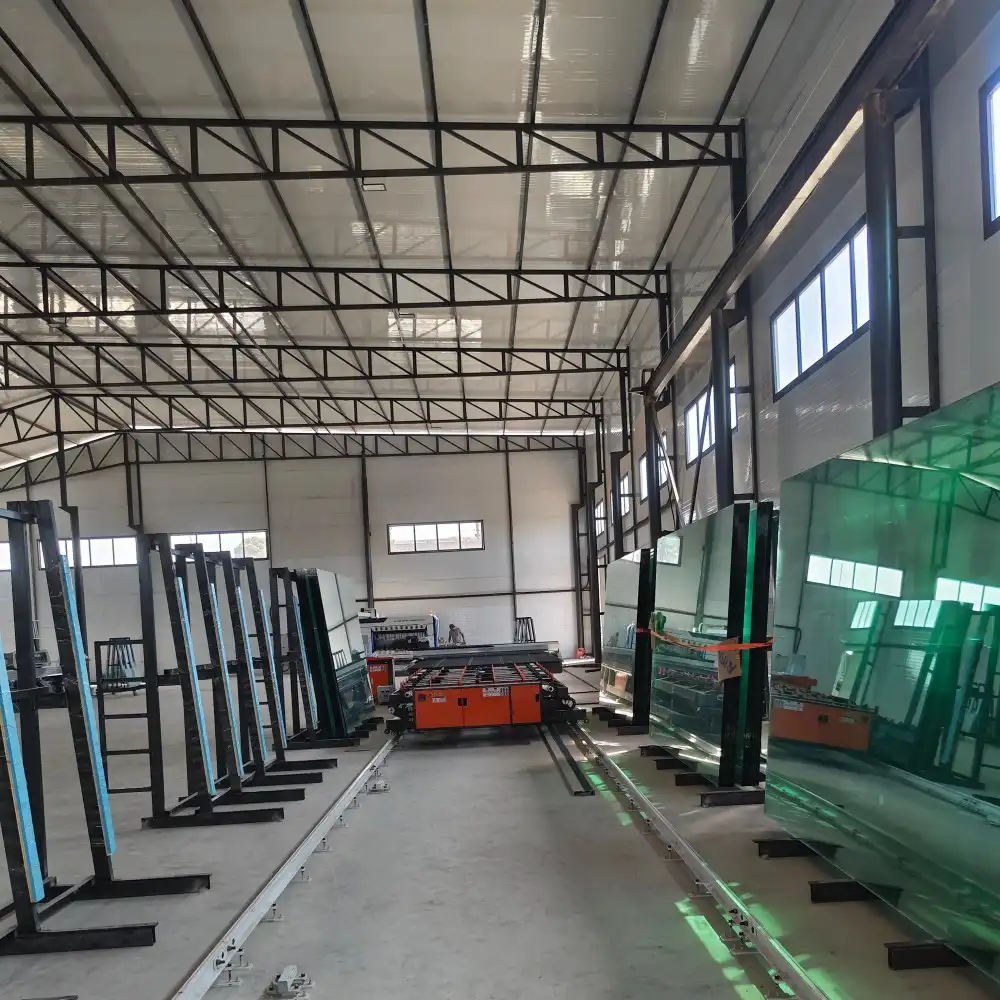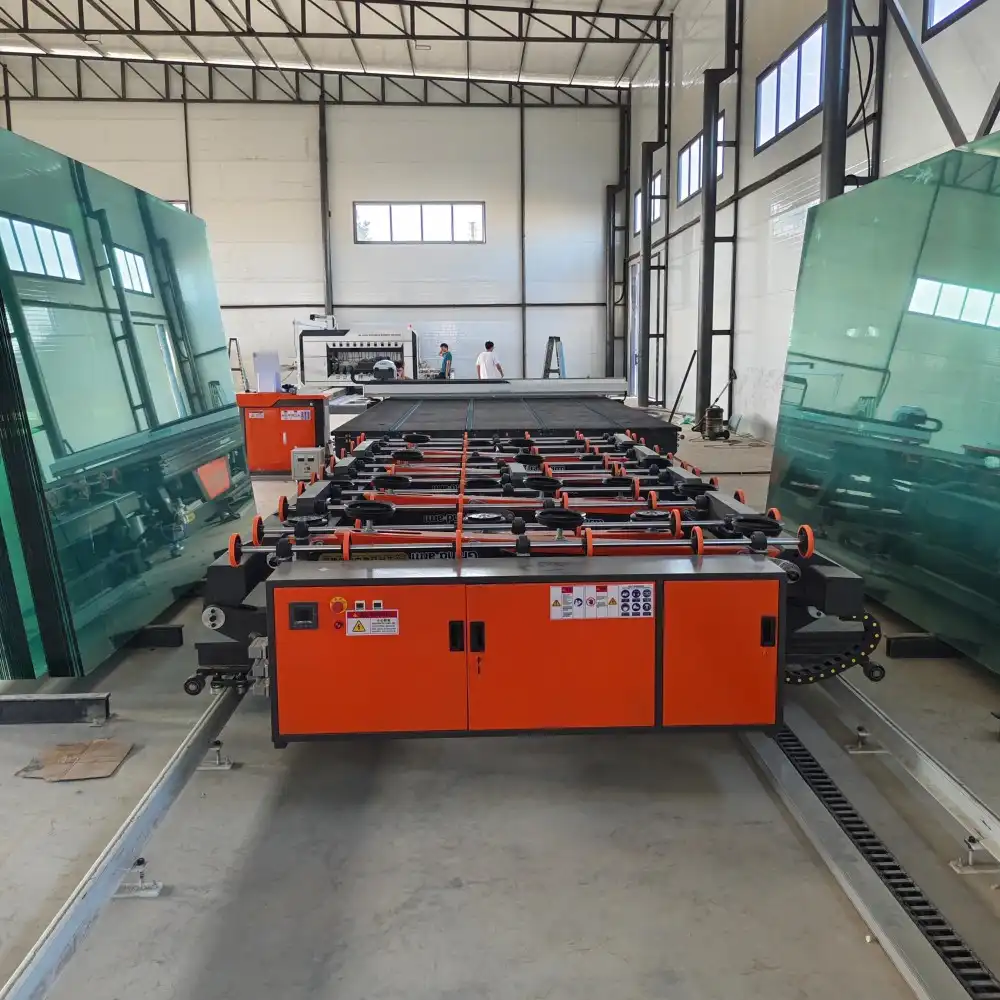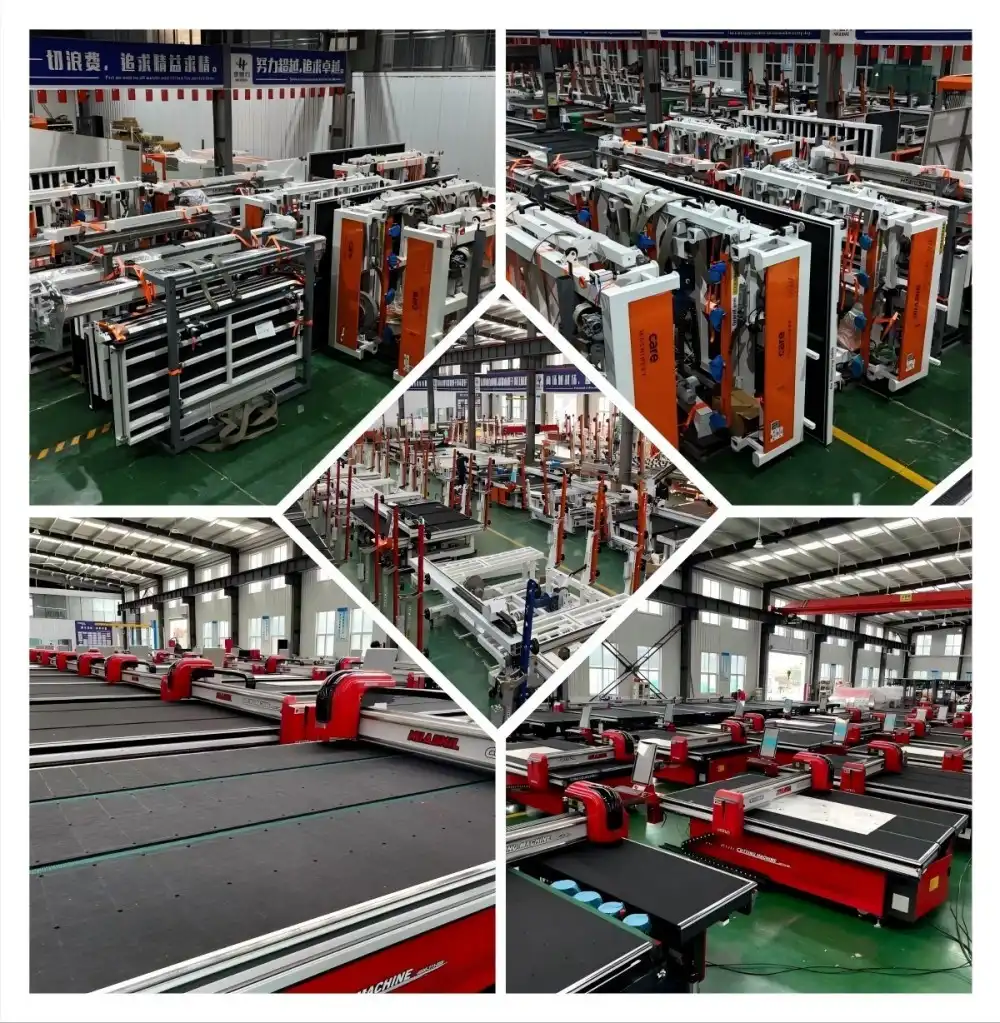In the world of glass manufacturing, efficiency and precision are paramount. The automatic glass cutting line has revolutionized the industry, offering unparalleled accuracy and productivity. Whether you're in the architectural, automotive, or smart mirror sector, understanding the key components of these cutting-edge machines is crucial for staying competitive in today's market. Let's dive into the essential elements that make up a state-of-the-art automatic glass cutting line and explore how they work together to deliver superior results.
What are the essential parts of an automatic glass cutting machine?
An automatic glass cutting machine is a complex system comprised of several critical components working in harmony. Each part plays a vital role in ensuring the precision and efficiency of the cutting process. Let's examine these key elements:
Loading System
The journey begins with the loading system. This component is responsible for transferring glass sheets from storage onto the cutting line. Advanced loading systems utilize vacuum suction cups or belts to handle glass sheets gently, preventing scratches or damage. The loading mechanism must be robust yet delicate, capable of handling various glass thicknesses and sizes without compromising speed or safety.
Cutting Bridge
The cutting bridge is the heart of the automatic glass cutting line. It houses the cutting head and moves along the X-axis of the machine. The bridge's stability and precision are crucial for achieving accurate cuts. High-quality bridges are constructed from materials like aluminum or steel, designed to minimize vibration and maintain rigidity during operation.

Cutting Head
Mounted on the cutting bridge, the cutting head is where the magic happens. It contains the cutting wheel, which scores the glass surface. Modern cutting heads often feature automatic pressure control, adjusting the cutting force based on glass thickness and type. This adaptability ensures clean, precise cuts across a wide range of glass products.
Control System
The brain of the operation, the control system, coordinates all machine functions. It interprets CAD drawings or cutting patterns, translating them into precise movements for the cutting head. Advanced control systems offer features like real-time monitoring, fault diagnosis, and remote operation capabilities, enhancing overall efficiency and reducing downtime.
Conveyor System
The conveyor system in a customized automatic glass cutting line is responsible for moving glass sheets through different stages of the cutting process. It must provide smooth, controlled movement to prevent glass displacement during cutting. High-quality conveyor systems use materials like felt or air cushions to protect the glass surface while ensuring accurate positioning.
Breaking System
After scoring, the glass needs to be broken along the scored lines. The breaking system applies controlled pressure to separate the glass pieces cleanly. Advanced breaking systems use pneumatic or hydraulic mechanisms to ensure precise, consistent breaks without damaging the glass edges.
Waste Removal System
Efficient waste management is crucial for maintaining a clean and safe working environment. The waste removal system collects and disposes of glass fragments and dust generated during the cutting process. This component often includes vacuum or conveyor belt systems to transport waste to designated collection points.
Understanding these core components is essential for anyone looking to invest in or operate an automatic glass cutting line. Each element contributes to the machine's overall performance, and their seamless integration is what makes modern glass cutting so efficient and precise.

How does the conveyor system work in an automatic glass cutting line?
The conveyor system is a crucial component of any automatic glass cutting line, serving as the backbone of the entire operation. Its primary function is to transport glass sheets through various stages of the cutting process with precision and care. Let's delve into the intricacies of this system and explore how it contributes to the overall efficiency of glass cutting operations.
Types of Conveyor Systems
There are several types of conveyor systems used in automatic glass cutting lines, each with its own advantages:
- Belt Conveyors: These use a continuous belt made of materials like PVC or rubber to transport glass sheets. They're known for their smooth operation and ability to handle various glass sizes.
- Roller Conveyors: Consisting of a series of powered rollers, these systems offer excellent stability and are ideal for heavier glass sheets.
- Air Float Conveyors: These innovative systems use a cushion of air to "float" the glass, minimizing friction and the risk of scratches.
Key Features of Modern Conveyor Systems
Modern conveyor systems in automatic glass cutting lines boast several advanced features:
- Precision Positioning: High-end systems use encoders and sensors to ensure glass sheets are positioned accurately for cutting.
- Speed Control: Variable speed settings allow for optimal throughput based on glass type and cutting requirements.
- Gentle Handling: Soft-touch materials and controlled acceleration/deceleration protect glass surfaces from damage.
- Integration with Control Systems: Seamless communication with the main control unit ensures synchronized operation with other machine components.
The Conveyor System in Action
Here's a step-by-step look at how the conveyor system operates within an automatic glass cutting line:
- Loading: Glass sheets are placed onto the conveyor from the loading system.
- Transport to Cutting Area: The conveyor moves the glass to the precise position for cutting.
- Stabilization: Once in position, the system holds the glass steady for the cutting process.
- Incremental Movement: As cutting progresses, the conveyor makes small, precise movements to facilitate complex cutting patterns.
- Transfer to Breaking Station: After cutting, the conveyor moves the scored glass to the breaking area.
- Unloading: Finally, cut glass pieces are transported to the unloading area or next processing station.
Maintenance and Optimization
To ensure peak performance of the conveyor system:
- Regular cleaning and lubrication of moving parts are essential.
- Periodic alignment checks help maintain precision.
- Replacing worn belts or rollers prevents quality issues.
- Upgrading control software can enhance system efficiency and capabilities.
The conveyor system's role in an automatic glass cutting line cannot be overstated. Its seamless operation ensures that glass sheets move through the cutting process with the utmost care and precision, contributing significantly to the overall quality and efficiency of glass production.

Importance of cutting head technology in automated glass processing
The cutting head is the pinnacle of precision in any automatic glass cutting line. It's where the actual scoring of the glass occurs, and its technology directly impacts the quality, speed, and versatility of the entire cutting process. Let's explore why cutting head technology is so crucial and how it's evolving to meet the demands of modern glass manufacturing.
The Evolution of Cutting Head Technology
Cutting head technology has come a long way from the early days of manual glass cutting. Today's cutting heads are marvels of engineering, incorporating advanced materials, precision mechanics, and smart electronics. This evolution has led to several key advancements:
- Carbide Cutting Wheels: Modern cutting wheels are made from ultra-hard materials like tungsten carbide, ensuring longevity and consistent cutting quality.
- Automatic Pressure Adjustment: Cutting heads can now automatically adjust pressure based on glass thickness and type, ensuring optimal scoring without over-stressing the glass.
- Multi-Axis Movement: Advanced cutting heads can move in multiple axes, allowing for complex cutting patterns and shapes.
- Integrated Lubrication Systems: These systems apply a fine mist of cutting oil to reduce friction and extend wheel life.
Key Features of Advanced Cutting Heads
The latest cutting head technologies offer a range of features that enhance the capabilities of a customized automatic glass cutting line:
- High-Speed Operation: Cutting speeds of up to 300 meters per minute are now possible, significantly boosting productivity.
- Precision Control: Cutting heads can maintain accuracy to within 0.1mm, crucial for applications like smart mirrors and automotive glass.
- Quick-Change Systems: Rapid tool change mechanisms minimize downtime during wheel replacements or maintenance.
- Sensor Integration: Built-in sensors monitor cutting force, wheel wear, and other parameters in real-time, ensuring consistent quality.
- Adaptability: Advanced cutting heads can handle a wide range of glass thicknesses and types without manual adjustments.
The Impact on Glass Processing
The advancements in cutting head technology have had far-reaching effects on the glass processing industry:
- Improved Quality: Precise, clean cuts reduce the need for secondary processing and minimize waste.
- Enhanced Productivity: Faster cutting speeds and reduced setup times lead to higher output.
- Greater Flexibility: The ability to handle various glass types and thicknesses on a single line increases operational flexibility.
- Energy Efficiency: Optimized cutting processes require less energy, contributing to more sustainable manufacturing practices.
- Cost Reduction: While initial investment may be higher, advanced cutting heads offer long-term cost savings through reduced waste and increased efficiency.
Future Trends in Cutting Head Technology
As we look to the future, several exciting developments are on the horizon for cutting head technology:
- AI-Driven Optimization: Machine learning algorithms will further refine cutting parameters in real-time, adapting to subtle variations in glass properties.
- Advanced Materials: New cutting wheel materials and coatings will offer even longer life and improved performance.
- Integration with Industry 4.0: Cutting heads will become more interconnected, sharing data with other systems for comprehensive process optimization.
- Non-Contact Cutting: Innovations in laser and water jet cutting may revolutionize certain aspects of glass processing.
The cutting head is more than just a component of an automatic glass cutting line; it's the technological heart that drives innovation and efficiency in glass processing. As manufacturers strive for ever-greater precision, speed, and versatility, cutting head technology will continue to evolve, pushing the boundaries of what's possible in glass manufacturing.
Conclusion
The automatic glass cutting line represents a pinnacle of engineering in the glass manufacturing industry. From the intricate workings of the conveyor system to the precision of cutting head technology, each component plays a vital role in delivering high-quality glass products efficiently and consistently. As we've explored, the synergy between these elements is what makes modern glass cutting lines so powerful and versatile.
For manufacturers looking to stay competitive in today's fast-paced market, investing in a cutting-edge automatic glass cutting line is not just an option—it's a necessity. The benefits of increased productivity, reduced waste, and improved product quality can significantly impact your bottom line and market position.
At Shandong Huashil Automation Technology Co., LTD, we understand the critical role that advanced glass cutting technology plays in your success. Our team of experts is dedicated to providing state-of-the-art solutions tailored to your specific needs. With years of experience in R&D, manufacturing, and export, we offer not just machinery, but a partnership focused on elevating your glass production capabilities.
Ready to transform your glass cutting operations? Don't hesitate to reach out to us. Our team is eager to discuss how our advanced automatic glass cutting lines can propel your business forward. Contact us at salescathy@sdhuashil.com to explore the possibilities and take the first step towards optimizing your glass production process.
References
1. Glass Technology Institute. (2023). "Advancements in Automatic Glass Cutting Line Technologies: A Comprehensive Review."
2. Journal of Industrial Automation. (2022). "The Role of Precision Engineering in Modern Glass Manufacturing Processes."
3. International Glass Processing Symposium Proceedings. (2023). "Optimization Strategies for High-Speed Glass Cutting in Automotive and Architectural Applications."
4. Global Glass Industry Report. (2022). "Market Trends and Technological Innovations in Automatic Glass Cutting Systems."



